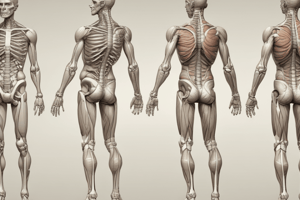Podcast
Questions and Answers
What is an example of a Synovial Plane joint?
What is an example of a Synovial Plane joint?
- Intercarpal joint (correct)
- Elbow
- Knee joint
- Shoulder joint
Which joint is known as the Knee joint?
Which joint is known as the Knee joint?
- Synovial Plane joint
- Synovial Modified hinge joint (correct)
- Synovial Ball-and-socket joint
- Synovial Hinge joint
What is the type of joint at the Elbow?
What is the type of joint at the Elbow?
- Synovial Pivot joint
- Synovial Hinge joint (correct)
- Synovial Plane joint
- Cartilaginous Symphesis
Which joint allows for rotation of the head?
Which joint allows for rotation of the head?
What is the other name for the Coronal suture?
What is the other name for the Coronal suture?
What type of joint is between the tibia and fibula?
What type of joint is between the tibia and fibula?
What is the classification of the joint found at the pubis symphysis?
What is the classification of the joint found at the pubis symphysis?
What type of joint is the shoulder joint?
What type of joint is the shoulder joint?
Flashcards
Synovial Plane Joints
Synovial Plane Joints
Permit gliding movements; found in intercarpal, intertarsal, sternoclavicular, acromioclavicular, sternocostal, and vertebrocostal joints.
Synovial Modified Hinge Joint
Synovial Modified Hinge Joint
Allow flexion and extension with a slight degree of rotation; example is the knee joint.
Synovial Hinge Joints
Synovial Hinge Joints
Permit movement in one plane (flexion and extension); examples are the elbow, ankle, and interphalangeal joints.
Synovial Pivot Joints
Synovial Pivot Joints
Signup and view all the flashcards
Synovial Condyloid Joints
Synovial Condyloid Joints
Signup and view all the flashcards
Synovial Saddle Joint
Synovial Saddle Joint
Signup and view all the flashcards
Synovial Ball-and-Socket Joints
Synovial Ball-and-Socket Joints
Signup and view all the flashcards
Fibrous Sutures
Fibrous Sutures
Signup and view all the flashcards
Study Notes
Synovial Joints
-
Synovial Plane Joints: Allow gliding movements.
- Intercarpal joint: Located between carpal bones at the wrist.
- Intertarsal joint: Found between tarsal bones at the ankle.
- Sternoclavicular joint: Connects the manubrium of the sternum with the clavicle.
- Acromioclavicular joint: Joins the acromion of the scapula and the clavicle.
- Sternocostal joint: Links the sternum with the costal cartilages of the second to seventh ribs.
- Vertebrocostal joints: Formed between rib heads/tubercles and thoracic vertebrae.
-
Synovial Modified Hinge Joint: Allows flexion and extension with slight rotational movement.
- Knee joint: Complex joint allowing for both bending and a degree of rotation.
-
Synovial Hinge Joints: Permit movement in one plane (flexion and extension).
- Elbow joint: Classic hinge joint connecting the humerus with the radius and ulna.
- Ankle joint: Allows for dorsiflexion and plantarflexion movements.
- Interphalangeal joints: Joints between finger and toe phalanges.
-
Synovial Pivot Joints: Permit rotational movement around a single axis.
- Atlanto-axial joint: Allows head rotation, essential for "no" movement.
- Radioulnar joint: Enables rotation from palm facing down (pronation) to up (supination).
-
Synovial Condyloid Joints: Allow movement but restrict rotation.
- Radiocarpal joint: Connects the radius and carpal bones allowing wrist movements.
- Metacarpophalangeal joints II-V: Joints between metacarpals and proximal phalanges.
-
Synovial Saddle Joint: Allows for movement in two planes.
- Carpometacarpal joint: Between the trapezium bone and metacarpal I, critical for thumb mobility.
-
Synovial Ball-and-Socket Joints: Enable a wide range of motion including rotational.
- Shoulder joint: Humeral head fits into the glenoid cavity of the scapula.
- Hip joint: Femoral head fits into the acetabulum of the pelvis, supporting weight and facilitating a range of movements.
Fibrous Joints
-
Fibrous Sutures: Immovable joints united by connective tissue.
- Coronal suture: The fibrous joint between the frontal and parietal bones of the skull.
-
Fibrous Syndesmosis: Slightly movable joints where bones are connected by ligaments.
- Distal tibiofibular joint: Connects the tibia and fibula near the ankle, allowing limited movement.
-
Fibrous Interosseous Membrane: A type of syndesmosis.
- Found between the tibia and fibula, providing stability and support.
Cartilaginous Joints
-
Cartilaginous Synchondrosis: Joints where bones are joined by hyaline cartilage.
- Epiphyseal plate: Found between the diaphysis and epiphysis of long bones, crucial for growth during development.
-
Cartilaginous Symphysis: Joints where fibrocartilage is present.
- Pubic symphysis: Located between the pubic bones, allows slight movement.
- Intervertebral joints: Connect the vertebrae with fibrocartilage, aiding shock absorption and flexibility.
Studying That Suits You
Use AI to generate personalized quizzes and flashcards to suit your learning preferences.




